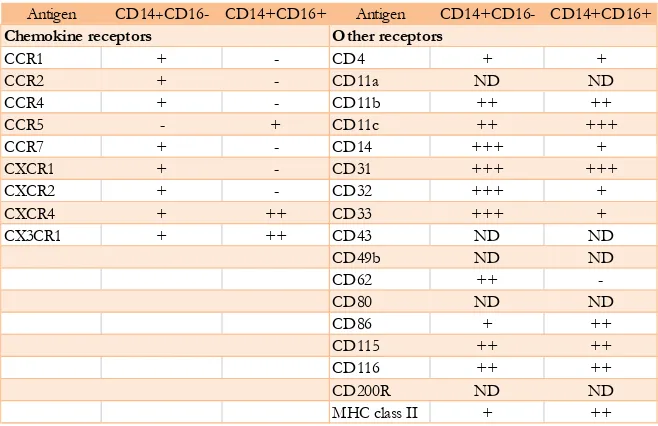Functional characterization of the CD300e leukocyte receptor
Texto completo
Figure
![Figure 1. Hematopoietic tree for the development of myeloid cells [1].](https://thumb-us.123doks.com/thumbv2/123dok_es/5314990.98532/20.499.151.350.112.353/figure-hematopoietic-tree-development-myeloid-cells.webp)
![Figure 2. Cytokine-induced differentiation of macrophage dendritic progenitors (MDP) and common DCs-progenitors CDP progenitors [1]](https://thumb-us.123doks.com/thumbv2/123dok_es/5314990.98532/21.499.158.341.70.216/figure-cytokine-differentiation-macrophage-dendritic-progenitors-progenitors-progenitors.webp)

![Figure 3. M1 and M2 macrophages, the extremes of a continuum [45].](https://thumb-us.123doks.com/thumbv2/123dok_es/5314990.98532/27.499.157.340.64.380/figure-m-m-macrophages-extremes-continuum.webp)
Documento similar
In particular, different versions of the training set for the base learners can be used, as in bagging (bootstrap sampling of training data), class-switching (noise injection in
Of special concern for this work are outbreaks formed by the benthic dinoflagellate Ostreopsis (Schmidt), including several species producers of palytoxin (PLTX)-like compounds,
(2015) Human Epidermal Growth Factor Receptor 2 (HER2)–specific chimeric antigen receptor–modified T cells for the Immunotherapy of HER2- positive sarcoma.. Journal of
Although Asian American critics have historically shunned any literary model that examines an Asian past, calling instead for a sustained critique of American
Anti-epidermal growth factor receptor therapy in combination with chemoradiotherapy for the treatment of locally advanced anal canal carcinoma: results of a phase I
Conversely, the evaluation of mRNA levels of genes encoding pro-in flammatory cytokines [interleukin-1 beta (IL-1 b ), tumor necrosis factor alpha (TNF a ), and transforming
Growth regulation of human colon cancer cells by epidermal growth factor and 1,25-dihydroxyvitamin D 3 is mediated by mutual modulation of receptor expression. The down-regulation
Catalase treatment decreases transforming growth factor-β1 (TGF-β1) mRNA and promoter activity, inhibits the binding of AP-1 to TGF-β1 promoter and reduces the 3TP-Lux
![Figure 4. Pattern-recognition receptor system in phagocytes [56]](https://thumb-us.123doks.com/thumbv2/123dok_es/5314990.98532/28.499.126.375.193.488/figure-pattern-recognition-receptor-system-in-phagocytes.webp)
![Figure 5. The current view of the ways in which the activation states of DCs can determine the nature of T-cell responses [57]](https://thumb-us.123doks.com/thumbv2/123dok_es/5314990.98532/30.499.136.362.68.321/figure-current-view-activation-states-determine-nature-responses.webp)
![Figure 6. Neutrophils deliver multiple anti-microbial molecules [67].](https://thumb-us.123doks.com/thumbv2/123dok_es/5314990.98532/32.499.86.416.274.427/figure-neutrophils-deliver-multiple-anti-microbial-molecules.webp)
![Figure 7. Neutrophils interact with monocytes, dendritic cells, T cells and B cells in a bidirectional, multi-compartmental manner [67]](https://thumb-us.123doks.com/thumbv2/123dok_es/5314990.98532/34.499.107.395.69.409/figure-neutrophils-interact-monocytes-dendritic-bidirectional-compartmental-manner.webp)
![Figure 8. Schematic presentation of the role of TREM1 in inflammatory responses [91].](https://thumb-us.123doks.com/thumbv2/123dok_es/5314990.98532/38.499.97.404.111.323/figure-schematic-presentation-role-trem-inflammatory-responses.webp)
![Figure 9. Siglec-family proteins in humans and rodents [122].pDCs, plasmacytoid dendritic cells; Schw, Schwann cells; Troph, trophoblasts](https://thumb-us.123doks.com/thumbv2/123dok_es/5314990.98532/41.499.87.414.70.359/figure-siglec-proteins-rodents-plasmacytoid-dendritic-schwann-trophoblasts.webp)